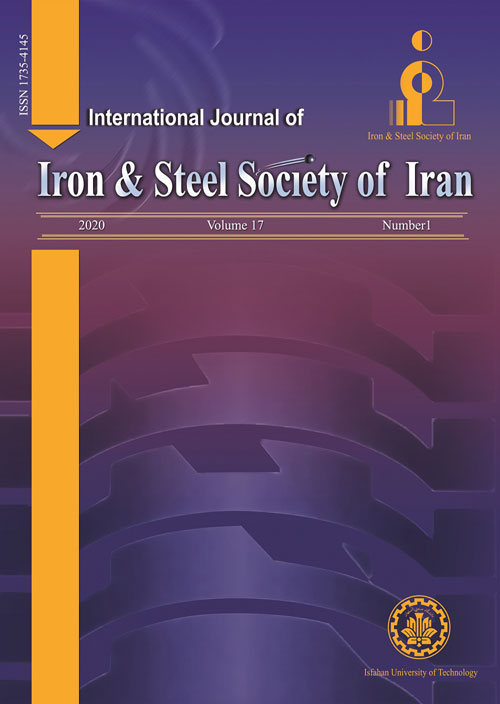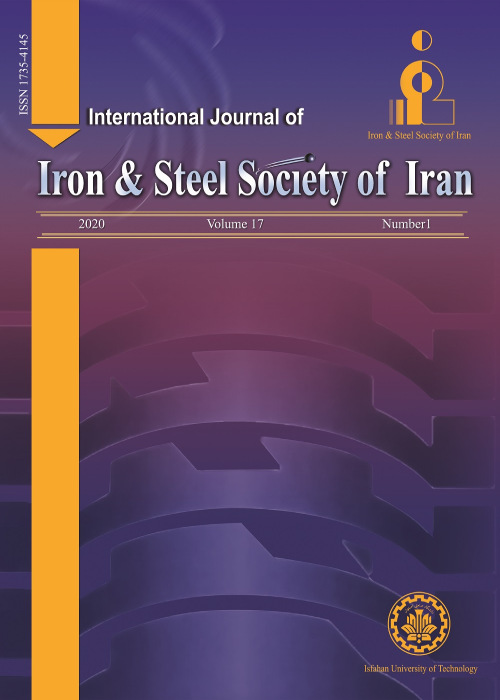فهرست مطالب

International Journal of iron and steel society of Iran
Volume:17 Issue: 1, Winter and Spring 2020
- تاریخ انتشار: 1400/02/12
- تعداد عناوین: 6
-
-
صفحات 1-10
اتصال غیرهمجنس فولادهای زنگ نزن به فولادهای کربنی یکی از انواع پرکاربرد اتصالهای غیرهمجنس است. در این تحقیق، ریزساختار و خواص مکانیکی SMAW غیرهمجنس فولاد زنگ نزن آستنیتی AISI 316L به فولاد کم کربن St-37 بررسی شده است. اتصالها توسط الکترود E316L و تحت سه حرارت ورودی مختلف 72/0، 84/0 و kJ mm-1 1 انجام شد. ریزساختار اتصالها توسط میکروسکوپ نوری و میکروسکوپ الکترونی روبشی بررسی شد. خواص مکانیکی اتصالها نیز به وسیله آزمون کشش و سختی سنجی مورد بررسی قرار گرفت. ریزساختار انجمادی فلز جوش عمدتا شامل آستنیت به همراه مقدار اندکی فریت دلتای اسکلتی بود. در فصل مشترک فلز جوش با ناحیه متاثر از حرارت فولاد AISI 316L، رشد همبافته مشاهده شد و در فصل مشترک فلز جوش با ناحیه متاثر از حرارت فولاد St-37، ناحیه باریک اچ نشده ای وجود دارد که به نظر می رسد ساختار آستنیتی-مارتنزیتی دارد. نتایج آزمون سختی نشان داد که سختی فصل مشترک فلز جوش با فولاد St-37 حداکثر سختی را دارد که به تشکیل نوار باریک مارتنزیتی نسبت داده می شود. نتایج آزمون کشش مشخص کرد که افزایش حرارت ورودی استحکام کششی را کاهش داده و ازدیاد طول اتصالها را افزایش می دهد.
کلیدواژگان: فولاد St-37، فولاد زنگ نزن AISI 316L، جوشکاری غیرهمجنس، ریزساختار، خواص کششی -
صفحات 21-27
فورم های هوای دم یا شیپورک های دمنده هوا از جمله قطعات مصرفی و حساس کوره های بلند بوده که وظیفه دمش هوای داغ به داخل کوره را بر عهده داشته و عملکرد صحیح آنها تاثیر مستقیم بر فرایند ذوب آهن در کوره بلند دارد. این قطعات معمولا در اثر قرار گرفتن در دمای بالا، تشعشع، پاشش مذاب و سرباره، طراحی نامناسب سیستم آبگرد، هدایت حرارتی پایین، مشکلات اپراتوری و غیره دچار آسیب و انهدام می شوند. در این مقاله براساس شرایط کوره، دو طراحی آبگرد ساده و اسپیرالی شبیه سازی شده و از نظر انتقال حرارت و افت فشار سیال مورد بررسی قرار گرفته است. براساس نتایج بدست آمده در طراحی اسپیرالی آب با دمای پایین تر به سمت نواحی بحرانی بدنه هدایت شده و با سرعت بیشتری نسبت به طراحی ساده از این نواحی عبور می کند؛ همچنین قدرت خنک کنندگی طراحی اسپیرالی برای بدنه فورم های هوای دم کارآمدتر بوده و به جلوگیری از سوختن این قطعه از این نواحی کمک شایانی خواهد نمود. براساس شبیه سازی انجام شده میزان فشار آب در طراحی اسپیرالی نسبت به طراحی ساده به میزان ناچیزی افت بیشتری خواهد داشت.
کلیدواژگان: فورم هوای دم، شیپورک دمنده هوا، کوره بلند، طراحی آبگرد اسپیرالی، انتقال حرارت
-
Pages 1-10
Joining of stainless steels to carbon steels is one of the most widely used types of dissimilar joints. In this research, the microstructure and mechanical properties of dissimilar shielded metal arc welding of austenitic stainless steel AISI 316L to carbon steel St-37 is studied. This joining has made by E316L electrode and three heat inputs of 0.72, 0.84 and 1.0 kJ/mm. The microstructure of the joints was characterized by optical and scanning electron microscopy. The mechanical properties of the joints were evaluated by tensile and microhardness tests. The solidification microstructure of the weld metals contained mainly austenite and some skeletal delta ferrite. There was an epitaxial growth at the interface of the weld metal with the AISI 316L steel HAZ, and at the interface of the weld metal with the St-37 HAZ, there is an un-etched narrow area which is suggested to have austenitic-martensitic structure. The results of hardness tests showed that the hardnessof the interface of the weld metal with the St-37 steel was maximum which is attributed to the formation of the martensitic narrow band. The longitudinal tensile results showed that the increasing of the heat input decreaes the tensile strength and increases the elongation of the joints.
Keywords: St-37 steel, AISI 316L stainless steel, Dissimilar Welding, Microstructure, tensile properties -
Pages 11-20
In this research, the effect of Diffusion Depth and Heat-Affected Zone (HAZ) in Nanoparticles-Electrode Gas Metal Arc Welding (NE-GMAW) process with carbon dioxide protection on Heat Resistance Steel (SUH 310S) was investigated using the Image Processing (IP) and Simulation software. Welding speed (S), wire feed rate (F) and voltage (V) as effective parameters were considered for experimental tests. The Design of Experiment (DoE) was using the Taguchi method and performed in L11 without experiment replication. According to a Scanning Electron Microscope (SEM) images from the experiments, changes in three effective parameters were obtained. The voltage and wire feed rate had the most significant impact on increasing HAZ and ultimately the diffusion depth due to the increase of heat generated and the creation of a more comprehensive Weld Pool (WP). Experimental 11-samples was used by NI vision IP software to find the diffusion depth and surface zone of the HAZ. Results of the effect parameters in Image Processing and Simulation software showed validation for evaluating changes in HAZ.
Keywords: Gas Metal arc welding, Heat resistance steel, Heat-affected zone, Diffusion depth, image processing -
Pages 21-27
Tuyeres or air-blowing nozzles are considered sensitive parts of blast furnaces responsible for blowing hot air into the furnace, and their proper operation has a direct effect on the iron-melting process in the blast furnace. These parts are usually damaged or destroyed by exposure to high temperatures, radiation, slag or molten iron scattering, improper design of the water-circulating system, low thermal conductivity, operator problems, etc.In this paper, the two simple and spiral water-circulating designs are simulated and examined in heat transfer and fluid pressure drop under furnace conditions. Based on the results obtained from the spiral design, water is directed to the critical areas of the body at a lower temperature and passes through these areas quicker than the simple design.; Additionally, the cooling power of the spiral design is more efficient for the body of the tuyeres and will help prevent this part from burning in these areas. According to the simulation, the spiral design’s water pressure will drop slightly further than the simple design.
Keywords: tuyeres, air-blowing nozzle, blast furnace, spiral water-circulating design, Heat Transfer -
Pages 28-39
Austenitic steels have numerous applications in high-temperature environments. The thermally-grown chromia scale on the steel surface may be-come unstable at high temperatures and as a result, oxidation resistance of steel will decrease. A potentially method for improving oxidation properties is the use of composite coatings using techniques such as electroplating. In the present study, Ni-P-TiO2-Al2O3 composite coating was deposited on AISI 316 steel sub-strate by electroplating. The as-coated samples were examined with scanning electron microscopy (SEM) with energy dispersive spectroscopy (EDS). X-Ray diffraction (XRD) was also used to identify the formed phases in the as-coated structures. In order to evaluate oxidation behavior, isothermal oxidation and cy-clic oxidation were conducted at 800 ºC. Isothermal oxidation of uncoated steels revealed higher weight gain in comparison with Ni-P-TiO2-Al2O3 composite-coated samples. The coating layer limited the outward diffusion of Cr cation and the inward diffusion of oxygen anion and resulted in better oxidation resistance. According to the results of cyclic oxidation, coated substrates demonstrated excel-lent resistance against spallation and cracking.
Keywords: composite coating, electroplating, AISI 316 stainless steel, Oxidation -
Pages 40-56
In this research, the effect of fluid velocity on corrosion kinetics of X65 steel has been investigated in an aqueous solution containing CO2 and H2S according to the steel structures corrosion sensitivity in aqueous environments. Therefore, the aqueous solution saturated with CO2 and containing 50 ppm of H2S was used to perform the corrosion tests. The fluid velocity varied between 0 to 1000 rpm, and the tests were carried out at three different temperatures of 25, 45, and 65oC. During these tests at various periods, parameters like the iron ion concentration (iron count) (ICP) and instant corrosion rate using the LPR test were monitored. The corrosion products were characterized using XRD and SEM methods. Also, the kinetics and mechanism of the corrosion process were analyzed in these conditions. The results at various fluid velocities showed that the first layer containing mostly mackinawite does not have the appropriate density, in such a way that the porosities and micro-cracks can be a suitable route for corrosive ions to penetrate to the steel surface. Then, as time passed and the thickness of the corrosion product film increased, the number of porosities decreased; this led to the compactness of the product film and resulted in the decrease of diffusion and ion exchange in the interface and consequently the corrosion rate.
Keywords: Corrosion Mechanism, Carbon Dioxide (CO2), Hydrogen Sulfide (H2S), Fluid Velocity, Kinetics Analysis -
Pages 57-69In the current research, the welding of HSLA-100 steel was accomplished with three different heat inputs using the GTAW process. The microstructure of various joint zones was investigated utilizing an optical microscope and scanning electron microscope. For the purpose of assessing the impact of thermal cycles upon the extension and alterations in the heat-affected zone, the thermocouples were placed at distinct distances from the fusion line. The results indicated that the weld metal microstructure comprised of acicular ferrite and a number of polygonal and quasi-polygonal Ferrite with M/A constituent. An epitaxial growth was observed in the fusion line in all heat inputs. It was determined that the heat-affected zone microstructure consisted of two regions, namely a coarse-grained heat-affected zone with a granular and lath bainite microstructure and a fine-grained heat-affected zone with the prevailing microstructure of granular Bainite. The results indicated that increasing the heat input leads to a decrease in the amount of acicular ferrite and M/A constituent volume fraction in the weld metal and an increase in lath bainite in coarse-grained zone. It was found that by increasing the heat input from 0.78kJ/mm to 1.42 kJ/mm, the grain size increases from 29.2μm to 76.5 μm and from 15.7μm to 32.5μm in coarse-grained and fine-grained zone, respectively. The thermal cycles evaluation pertinent to the implanting of a thermocouple disclosed that the heat-affected zone width is extended from 3.6 mm to 4.5mm by increasing the heat input from 0.78kJ/mm to 1.42 kJ/mm.Keywords: HSLA-100 steel, Microstructure, Thermal cycles, granular bainite, acicular ferrite, M, A constituent


